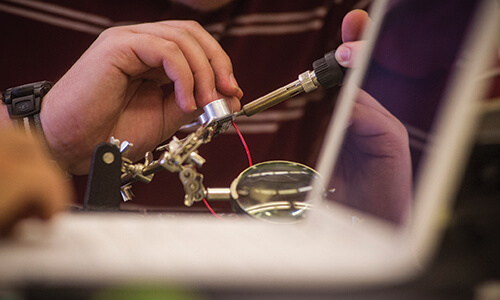The senior design project or capstone is a two-semester course sequence. Typically, it is the biggest academic project that students undertake in their undergraduate degree program. Under the guidance and supervision of a faculty member, students work in teams of three or four to first write a proposal in the area they choose to research. In the following semester, the team works to implement their project according to the design and specifications outlined in their proposal. Senior design is a culminating experience where students integrate the knowledge from all the courses taken to produce an innovative project.
For the 2022-2023 academic year, students have again shown their impressive skills and creativity to produce highly rated projects. The following is a sample of the projects:
Ultrasonic 3D Mapper: it is an ultrasonic transducer that produces pressure waves inside a glass tank and this pressure will be mapped as a 4D (X, Y, Z, Pressure) array using a hydrophone. This project covers the design process and build details for mechanical system to move the sensor, the software to control the system, and a user interface to interact with the data. The end goal of this project is to characterize and validate the output of ultrasonic transducer arrays for surgical applications. This mapping system gives detailed data on the pressure within a given volume to a resolution of 1cm. The design includes aspects of mechanical, electrical, and computer engineering but focuses on the electrical and computer aspects. This includes the gathering of sensor data, signal rectification, signal deconvolution, and code for a graphical user interface.
Bradycardia Detection and Alarming Device: The device uses a set of EKG leads that can directly measure the pulses from the heart. This allows for the detection of Bradycardia (a rapid drop-in heart rate) when, for example, a patient stops breathing. This will be accomplished using an existing board, that sends an analog signal to the detection software to find the R-Peaks in the QRS complex of the heartbeat. Once this heartbeat has fallen below a user-defined threshold, an alarm attached to the patient will vibrate. This vibration alarm will wake the patient up only enough to allow them to dislodge their tongue from their throat and resume their normal breathing.
EKG System: The design builds off the traditional electrocardiogram with its leads system but can be offered at a fraction of the price. The design is small, lightweight, and easy to use. This device will have a simple LCD display to set different thresholds for individual users and is easily controlled using buttons. The design of the system allows for the user to easily monitor their heart rate anywhere. With built-in functions, the device has heart rate drop software and buzzer to stimulate the patient when their heart rate drops below a set threshold. This system meets the needs of low-income patients and the elderly, while providing industry grade heart rate monitoring.
Robotic Arm Training System: The premise of this project is to create an intuitive system for robotics controls for commercial applications. There is a user input side and a robotic input side, sending and receiving data from each side to create and tune the desired movements so that they may be performed autonomously after being adequately tuned. This system requires a user input that can collect the type of data that the robotic arm can use to recreate the movement.
